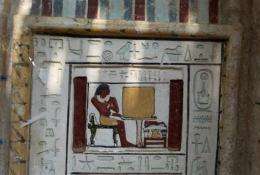Egypt unveils discovery of 4,300-year-old tombs

Egyptian archaeologists on Thursday unveiled a newly-unearthed double tomb with vivid wall paintings in the ancient necropolis of Saqqara near Cairo, saying it could be the start for uncovering a vast cemetery in the area.
The tomb includes two false doors with colorful paintings depicting the two people buried there, a father and a son who served as heads of the royal scribes, said Abdel-Hakim Karar, a top archaeologist at Saqqara.
"The colors of the false door are fresh as if it was painted yesterday," Karar told reporters.
Humidity had destroyed the sarcophagus of the father, Shendwas, while the tomb of the son, Khonsu, was robbed in antiquity, he said.
Also insribed on the father's false door was the name of Pepi II, whose 90-year reign is believed to be the longest of the pharaohs. The inscription dates the double tomb to the 6th dynasty, which marked the beginning of the decline of the Old Kingdom, also known as the age of pyramids.
Egypt's antiquities chief, Zahi Hawass, said the new finds were "the most distinguished tombs ever found from the Old Kingdom," because of their "amazing colors." He said the area, if excavated, could unveil the largest cemetery of ancient Egypt.
The paintings on the false doors identified Shendwas and Khonsu as royal scribes and "supervisors of the mission," meaning they were in charge of delegations overseeing the supply of materials used for pyramids construction.
A single shaft from the surface led down to the father's tomb, from which a side passage led to that of the son, with the false door with paintings of Khonsu in front of an offering table.
Hawass pointed to a handful of duck-shaped artifacts and a small obelisk made of limestone. Such obelisks were often buried with the dead in the 5th and 6th dynasties to show their veneration for the sun god, Ra. "These artifacts were found at the end of the burial shaft, at 18 meters (yards) depth, but we covered it up," Hawass told reporters.
Karar said that so far six tombs dating back to the end of the Old Kingdom have been unearthed since digging in the area three began three years ago. Work started on the double tomb five weeks ago.
The tombs lie just west of Saqqara's most famed pyramid, the Step Pyramid of King Djoser, which is surrounded by a large burial ground, contain tombs from Egypt's earliest history up through Roman times.
©2010 The Associated Press. All rights reserved. This material may not be published, broadcast, rewritten or redistributed.



















